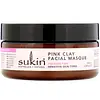What's inside
What's inside
 Key Ingredients
Key Ingredients

 Benefits
Benefits

 Concerns
Concerns

 Ingredients Side-by-side
Ingredients Side-by-side

Water
Skin ConditioningKaolin
AbrasiveBentonite
AbsorbentStearic Acid
CleansingCetyl Alcohol
EmollientAloe Barbadensis Leaf Juice
Skin ConditioningGlyceryl Stearate
EmollientCetearyl Alcohol
EmollientCaprylic/Capric Triglyceride
MaskingCoco-Caprylate
EmollientCeteareth-20
CleansingTasmannia Lanceolata Fruit/Leaf Extract
AntioxidantCucumis Sativus Fruit Extract
EmollientChamomilla Recutita Flower Extract
MaskingVanilla Planifolia Fruit Extract
Skin ConditioningTocopherol
AntioxidantGlycerin
HumectantHematite Powder
Iron Hydroxide
StabilisingAluminum Hydroxide
EmollientVanillin
MaskingXanthan Gum
EmulsifyingCitric Acid
BufferingEthylhexylglycerin
Skin ConditioningPhenoxyethanol
PreservativeBenzyl Alcohol
PerfumingWater, Kaolin, Bentonite, Stearic Acid, Cetyl Alcohol, Aloe Barbadensis Leaf Juice, Glyceryl Stearate, Cetearyl Alcohol, Caprylic/Capric Triglyceride, Coco-Caprylate, Ceteareth-20, Tasmannia Lanceolata Fruit/Leaf Extract, Cucumis Sativus Fruit Extract, Chamomilla Recutita Flower Extract, Vanilla Planifolia Fruit Extract, Tocopherol, Glycerin, Hematite Powder, Iron Hydroxide, Aluminum Hydroxide, Vanillin, Xanthan Gum, Citric Acid, Ethylhexylglycerin, Phenoxyethanol, Benzyl Alcohol
Water
Skin ConditioningGlycerin
HumectantPropanediol
SolventAcrylates/Beheneth-25 Methacrylate Copolymer
Phenoxyethanol
PreservativeLauryl Methacrylate/Glycol Dimethacrylate Crosspolymer
Melaleuca Alternifolia Leaf Oil
AntioxidantEthylhexylglycerin
Skin ConditioningSodium Hydroxide
BufferingSalicylic Acid
MaskingAllantoin
Skin ConditioningAloe Barbadensis Leaf Juice Powder
Skin ConditioningCalophyllum Inophyllum Seed Oil
AntimicrobialAcrylates/C10-30 Alkyl Acrylate Crosspolymer
Emulsion StabilisingTrisodium Ethylenediamine Disuccinate
Sodium Hyaluronate
HumectantHydrolyzed Algin
Limonene
PerfumingCitral
PerfumingPEG-30 Dipolyhydroxystearate
EmulsifyingTrideceth-6
EmulsifyingZinc Sulfate
AntimicrobialCitronellol
PerfumingLeptospermum Petersonii Oil
MaskingTocopherol
AntioxidantCaramel
Cosmetic ColorantCI 19140
Cosmetic ColorantCI 42090
Cosmetic ColorantWater, Glycerin, Propanediol, Acrylates/Beheneth-25 Methacrylate Copolymer, Phenoxyethanol, Lauryl Methacrylate/Glycol Dimethacrylate Crosspolymer, Melaleuca Alternifolia Leaf Oil, Ethylhexylglycerin, Sodium Hydroxide, Salicylic Acid, Allantoin, Aloe Barbadensis Leaf Juice Powder, Calophyllum Inophyllum Seed Oil, Acrylates/C10-30 Alkyl Acrylate Crosspolymer, Trisodium Ethylenediamine Disuccinate, Sodium Hyaluronate, Hydrolyzed Algin, Limonene, Citral, PEG-30 Dipolyhydroxystearate, Trideceth-6, Zinc Sulfate, Citronellol, Leptospermum Petersonii Oil, Tocopherol, Caramel, CI 19140, CI 42090
Ingredients Explained
These ingredients are found in both products.
Ingredients higher up in an ingredient list are typically present in a larger amount.
Ethylhexylglycerin (we can't pronounce this either) is commonly used as a preservative and skin softener. It is derived from glyceryl.
You might see Ethylhexylglycerin often paired with other preservatives such as phenoxyethanol. Ethylhexylglycerin has been found to increase the effectiveness of these other preservatives.
Glycerin is already naturally found in your skin. It helps moisturize and protect your skin.
A study from 2016 found glycerin to be more effective as a humectant than AHAs and hyaluronic acid.
As a humectant, it helps the skin stay hydrated by pulling moisture to your skin. The low molecular weight of glycerin allows it to pull moisture into the deeper layers of your skin.
Hydrated skin improves your skin barrier; Your skin barrier helps protect against irritants and bacteria.
Glycerin has also been found to have antimicrobial and antiviral properties. Due to these properties, glycerin is often used in wound and burn treatments.
In cosmetics, glycerin is usually derived from plants such as soybean or palm. However, it can also be sourced from animals, such as tallow or animal fat.
This ingredient is organic, colorless, odorless, and non-toxic.
Glycerin is the name for this ingredient in American English. British English uses Glycerol/Glycerine.
Learn more about GlycerinPhenoxyethanol is a preservative that has germicide, antimicrobial, and aromatic properties. Studies show that phenoxyethanol can prevent microbial growth. By itself, it has a scent that is similar to that of a rose.
It's often used in formulations along with Caprylyl Glycol to preserve the shelf life of products.
Tocopherol (also known as Vitamin E) is a common antioxidant used to help protect the skin from free-radicals and strengthen the skin barrier. It's also fat soluble - this means our skin is great at absorbing it.
Vitamin E also helps keep your natural skin lipids healthy. Your lipid skin barrier naturally consists of lipids, ceramides, and fatty acids. Vitamin E offers extra protection for your skin’s lipid barrier, keeping your skin healthy and nourished.
Another benefit is a bit of UV protection. Vitamin E helps reduce the damage caused by UVB rays. (It should not replace your sunscreen). Combining it with Vitamin C can decrease sunburned cells and hyperpigmentation after UV exposure.
You might have noticed Vitamin E + C often paired together. This is because it is great at stabilizing Vitamin C. Using the two together helps increase the effectiveness of both ingredients.
There are often claims that Vitamin E can reduce/prevent scarring, but these claims haven't been confirmed by scientific research.
Learn more about TocopherolWater. It's the most common cosmetic ingredient of all. You'll usually see it at the top of ingredient lists, meaning that it makes up the largest part of the product.
So why is it so popular? Water most often acts as a solvent - this means that it helps dissolve other ingredients into the formulation.
You'll also recognize water as that liquid we all need to stay alive. If you see this, drink a glass of water. Stay hydrated!
Learn more about Water